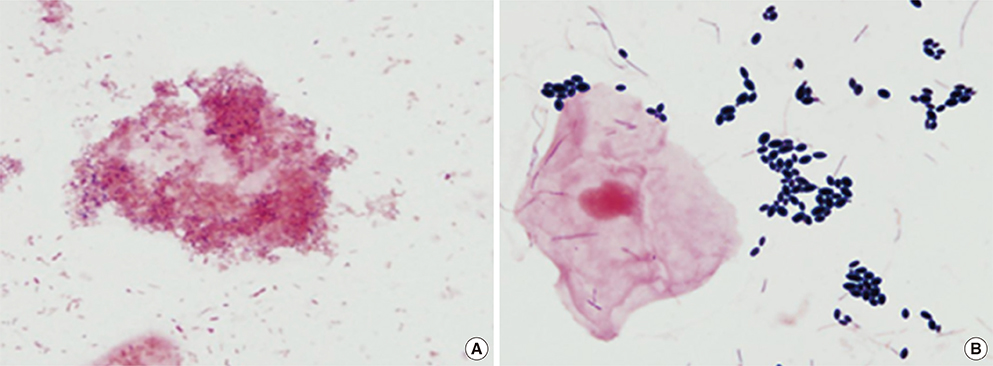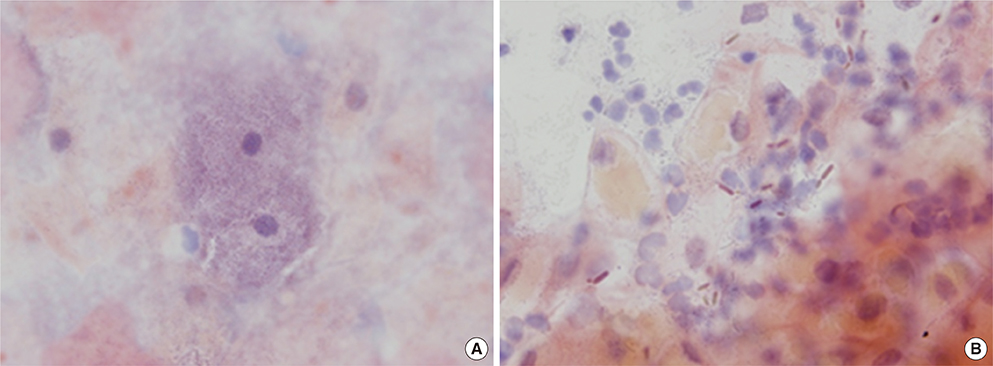Lab Med Online.
2014 Apr;4(2):105-111.
Interpretation of Papanicolaou Smear Test and Gram Stain Results for the Diagnosis of Infectious Vaginitis is Affected by Knowledge of Additional Related Test Results
- Affiliations
-
- 1Department of Laboratory Medicine, Chung-Ang University College of Medicine, Seoul, Korea. cpworld@cau.ac.kr
Abstract
- BACKGROUND
Infectious vaginitis is a common gynecologic disease that is primarily caused by three pathogens (Trichomonas vaginalis, Gardnerella vaginalis, and Candida species). The aim of this study was to confirm the effects of other infectious vaginitis-related test results on the interpretation of Gram stain and Papanicolaou (Pap) smear test results for disease diagnosis.
METHODS
A total of 300 vaginal samples were collected from women presenting symptoms of vaginitis. The presence of the three previously mentioned pathogens was evaluated using both a Gram stain and Pap smear test, and interpreted twice by 4 different observers. The first interpretation was performed without any information, and a second interpretation was performed with knowledge of results of an Affirm VPIII test that was used to diagnose infectious vaginitis. The results from the two interpretations were compared and the sensitivity and specificity of both tests were evaluated.
RESULTS
For the Gram stain samples, the detection rates of G. vaginalis were increased in the second interpretation by 6.2%, while the detection rates of Candida spp. were decreased by 0.3%. For the Pap smear test samples, the detection rates of G. vaginalis were increased in the second interpretation by 7.0%, and the detection rates of Candida spp. were increased by 2.0%. The sensitivity of both tests was increased in the second interpretation by 5.5% to 66.7%. There was no difference in the specificity between the two interpretations.
CONCLUSIONS
We demonstrated that there is significant inter-observer variation when using Gram stain and Pap smear test results to diagnose infectious vaginitis. The detection rates and sensitivity of both tests changed when the results from an additional test were incorporated into the interpretation. Additional studies are needed to develop objective criteria and a standardized interpretation system for the evaluation of results from these diagnostic tests.
Keyword
MeSH Terms
Figure
Reference
-
1. Van Der Pol B. Diagnosing vaginal infections: It's time to join the 21st century. Curr Infect Dis Rep. 2010; 12:225–230.
Article2. Verstraelen H, Verhelst R. Bacterial vaginosis: an update on diagnosis and treatment. Expert Rev Anti Infect Ther. 2009; 7:1109–1124.
Article3. Kent HL. Epidemiology of vaginitis. Am J Obstet Gynecol. 1991; 165:1168–1176.
Article4. Haefner HK. Current evaluation and management of vulvovaginitis. Clin Obstet Gynecol. 1999; 42:184–195.
Article5. Gravett MG, Hummel D, Eschenbach DA, Holmes KK. Preterm labor associated with subclinical amniotic fluid infection and with bacterial vaginosis. Obstet Gynecol. 1986; 67:229–237.
Article6. Saurina GR, McCormack WM. Trichomoniasis in pregnancy. Sex Transm Dis. 1997; 24:361–362.
Article7. Hurley R, De Louvois J. Candida vaginitis. Postgrad Med J. 1979; 55:645–647.
Article8. Cho SN. Updated treatment of vaginitis. Korean J Obstet Gynecol. 2005; 48:261–268.9. Hillier SL. Diagnostic microbiology of bacterial vaginosis. AM J Obstet Gynecol. 1993; 169:455–459.
Article10. Granato PA. Vaginitis: Clinical and laboratory aspects for diagnosis. Clin Microbiol Newsletter. 2010; 32:111–116.
Article11. Eriksson K, Forsum U, Bjørnerem A, Platz-Christensen JJ, Larsson PG. Validation of the use of Pap-stained vaginal smears for diagnosis of bacterial vaginosis. APMIS. 2007; 115:809–813.
Article12. Forsum U, Jakobsson T, Larsson PG, Schmidt H, Beverly A, Bjørnerem A, et al. An international study of the interobserver variation between interpretations of vaginal smear criteria of bacterial vaginosis. APMIS. 2002; 110:811–818.
Article13. Gazi H, Degerli K, Kurt O, Teker A, Uyar Y, Caglar H, et al. Use of DNA hybridization test for diagnosing bacterial vaginosis in women with symptoms suggestive of infection. APMIS. 2006; 114:784–787.
Article14. Nugent RP, Krohn MA, Hillier SL. Reliability of diagnosing bacterial vaginosis is improved by a standardized method of gram stain interpretation. J Clin Microbiol. 1991; 29:297–301.
Article15. Amsel R, Totten PA, Spiegel CA, Chen KC, Eschenbach D, Holmes KK. Nonspecific vaginitis. Diagnostic criteria and microbial and epidemiologic associations. Am J Med. 1983; 74:14–22.16. Kingston MA, Bansal D, Carlin EM. 'Shelf life' of Trichomonas vaginalis. Int J STD AIDS. 2003; 14:28–29.17. Platz-Christensen JJ, Larsson PG, Sundström E, Wiqvist N. Detection of bacterial vaginosis in wet mount, papanicolaou stained vaginal smears and in gram stained smears. Acta Obstet Gynecol Scand. 1995; 74:67–70.
Article18. Tokyol C, Aktepe OC, Cevrioğlu AS, Altindis M, Dilek FH. Bacterial vaginosis: comparison of Pap smear and microbiological test results. Mod Pathol. 2004; 17:857–860.
Article19. Sobel JD, Schmitt C, Meriwether C. A new slide latex agglutination test for the diagnosis of acute Candida vaginitis. Am J Clin Pathol. 1990; 94:323–325.
Article20. Reid G, Burton J, Hammond JA, Bruce AW. Nucleic acid-based diagnosis of bacterial vaginosis and improved management using probiotic lactobacilli. J Med Food. 2004; 7:223–228.
Article21. Levi AW, Harigopal M, Hui P, Schofield K, Chhieng DC. Comparison of Affirm VPIII and Papanicolaou tests in the detection of infectious vaginitis. Am J Clin Pathol. 2011; 135:442–447.
Article22. Briselden AM, Hillier SL. Evaluation of affirm VP Microbial Identification Test for Gardnerella vaginalis and Trichomonas vaginalis. J Clin Microbiol. 1994; 32:148–152.
Article23. Kim KH, Kim TH, Lee JH, Lee TJ, Lee MK. Detection of Trichomonas vaginalis, Gardnerella vaginalis, and Candida species in Affirm VPIII, Papanicolaou smear test and gram stain. Korean J Clin Microbiol. 2012; 15:104–109.
Article
- Full Text Links
- Actions
-
Cited
- CITED
-
- Close
- Share
- Similar articles
-
- Detection of Trichomonas vaginalis, Gardnerella vaginalis, and Candida Species in Affirm VPIII, Papanicolaou Smear Test and Gram Stain
- Value of Papanicolaou Smear in Detection of Bacterial Vaginosis
- Detection for Chlamydia trachomatis by Vidas Chlamydia Test and Direct Smear
- Clinical Usefulness of New Cervicography in Screening of Cervical Cancer
- Comarison of Acridine Orange and Gram Stains in the Diagnosis of Infectious Keratitis



